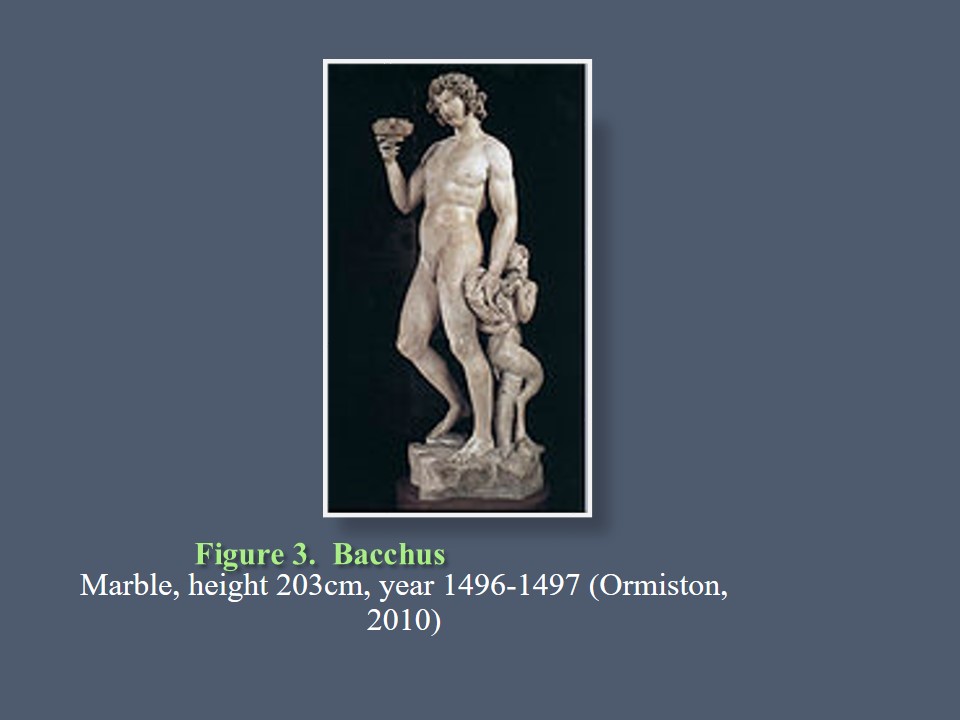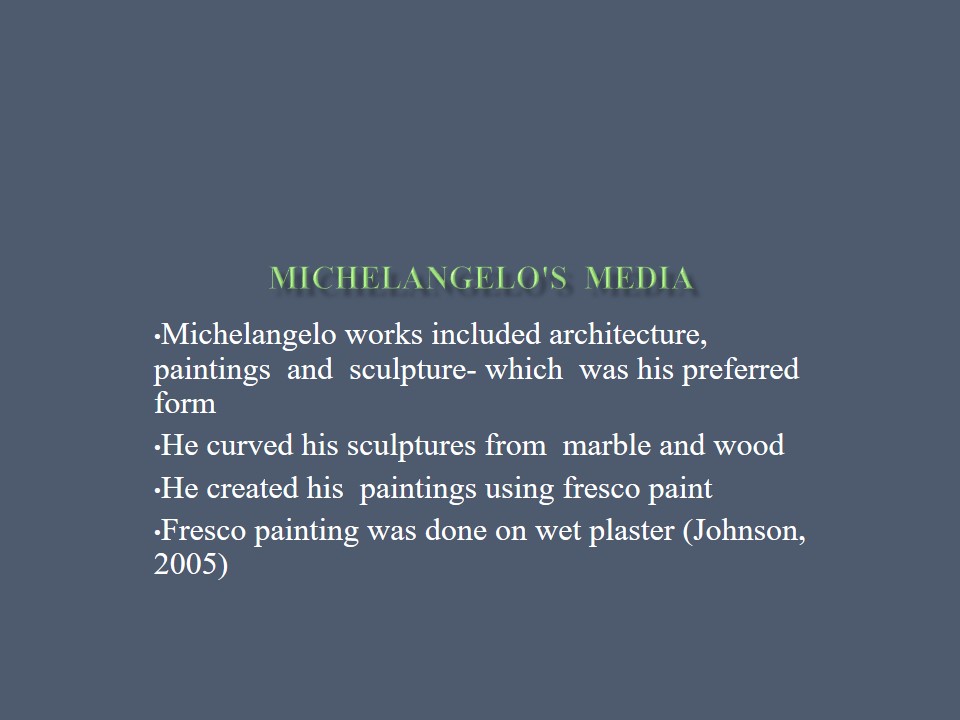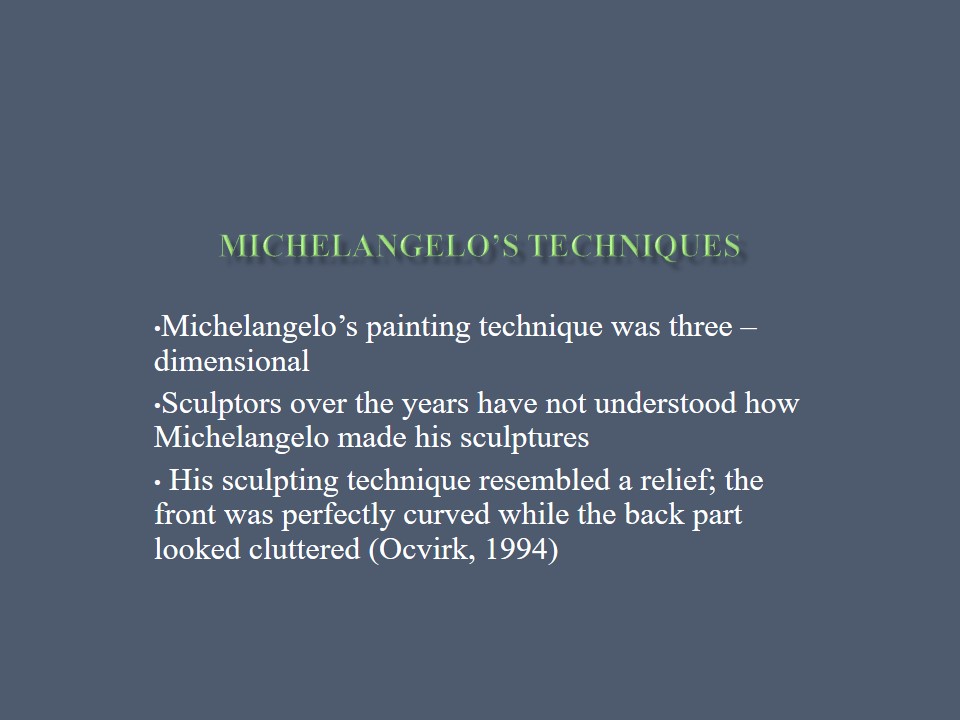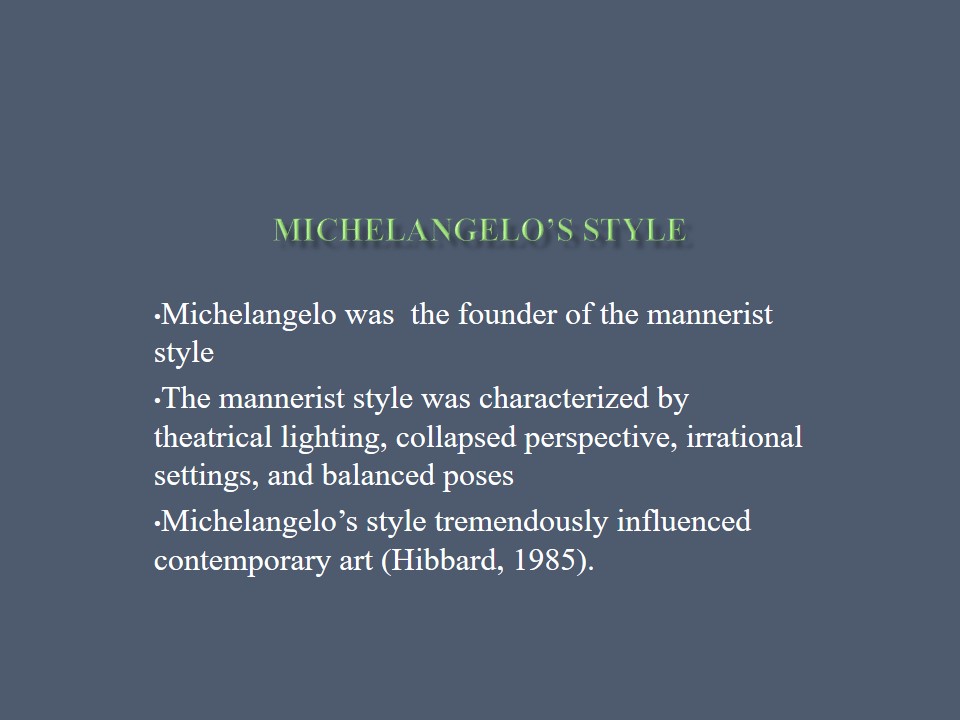- I was drawn to Michelangelo’s works because of:
- His unique style of art;
- He has been considered the greatest artist of all times;
- Michelangelo’s famous works like David and Pieta also drew my attention;



Michelangelo’s Biographical Information
- Michelangelo was born in 1475 in Caprese Italy.
- He studied grammar as a young boy in Florence.
- When he was thirteen he became an art apprentice to Domenico Ghirlandaio, a painter.
- Michelangelo studied at the Humanist Academy, which taught neo platonic philosophies (Johnson, 2005).
- Michelangelo was taught sculpture by Bertoldo di Giovanni.
- Michelangelo was a renaissance artist and his works were greatly influenced by humanism.
- He viewed the human body as a piece of art (Johnson, 2005).



Michelangelo’s Themes
- The dominant themes in Michelangelo’s work are religion and humanism.
- The theme of religion is seen in his works like: The painting on the ceiling of the Sistine Chapel.
- “The down fall of man”; the paintings represented catholic doctrines (Johnson, 2005).
- Certain Michelangelo’s works like the “Battle of the Centaurs” bring out special themes.
- This sculpture brings out the theme of “civilization over savagery”.
- Greek theme like “Greeks over barbarians “can also be seen in these sculpture (Johnson, 2005).





Michelangelo’s Media
- Michelangelo works included architecture, paintings and sculpture- which was his preferred form.
- He curved his sculptures from marble and wood.
- He created his paintings using fresco paint.
- Fresco painting was done on wet plaster (Johnson, 2005).



Michelangelo’s Techniques
- Michelangelo’s painting technique was three –dimensional.
- Sculptors over the years have not understood how Michelangelo made his sculptures.
- His sculpting technique resembled a relief; the front was perfectly curved while the back part looked cluttered (Ocvirk, 1994).
- Michelangelo’s carvings were dynamic and based on infinite planes.
- He did not pay attention to his preparatory drawings while curving.
- He used the bow drill in most of his carvings and refined them using gradina-toothed chisel (Hibbard, 1985).


Michelangelo’s Concept and Process
- Michelangelo conceptualized sculpture as the finest form of art because it resembles divine creation.
- This concept is referred to as disegno.
- Michelangelo does not reveal the process he uses in his art.
- However, it is agreed that his process was influenced by the idealized human form (Hibbard, 1985).


Michelangelo’s Style
- Michelangelo was the founder of the mannerist style.
- The mannerist style was characterized by theatrical lighting, collapsed perspective, irrational settings, and balanced poses.
- Michelangelo’s style tremendously influenced contemporary art (Hibbard, 1985).

Michelangelo’s Studio Practice
- Michelangelo’s studio practice included using fresco paint and the smooth method of painting that was not manually tangible.
- His studio practice resulted in the creation of smooth features that could be seen but not touched.
- Michelangelo freely curved his sculptures (Hibbard, 1985).

Public and Artists Reception of Michelangelo’s Works
- Michelangelo’s works were considered the greatest pieces during his time.
- In the modern times, Michelangelo’s works have been considered the greatest artistic works of all time.
- Artists like Giorgio Vasari have viewed and regarded Michelangelo’s works as master-pieces (Hibbard, 1985).
- Michelangelo’s “Last Judgment” attracted varied responses among his critiques.
- Those who opposed the art claimed that it showed arrogance and abuse of art.
- However, his proponents argued that the art portrayed a sense of beauty (Hibbard, 1985).



My Opinion on Michelangelo’s Works
- After reading and seeing the images of Michelangelo’s works, my opinion about his works greatly changed.
- This is because I saw how his style, techniques , methods, and pieces of art were unique.
- His works also showed magnificent creativity and excellence.

References
Hibbard, H. (1985). Michelangelo. Cambridge, MA: Harper & Row.
Johnson, G. A. (2005). Renaissance art : A very short introduction.. Oxford: Oxford University Press.
Ocvirk, O. G. (1994). Art fundamentals : Theory and practice. Madison, WI: W.M.C. Brown Publishers.
Ormiston, R. (2010). Michelangelo : His life and works in 500 images. London : Lorenz.